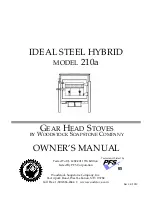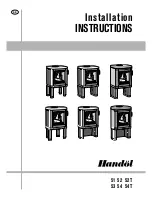
CHIMNEYS
Your chimney is a critical component of your wood heating system. A properly designed and constructed chimney
will help to provide safe and efficient woodstove operation. Hot exhaust rising up through the chimney also pulls com-
bustion air into the stove through the air damper. If a chimney is too short, or the flue too large, the hot exhaust will cool
and slow down. This can lead to poor stove performance, smoke spillage, back puffing, and even creosote build up in
the chimney itself. An excessively tall chimney could lead to a strong draft, which may make the fire difficult to control
with the stove damper. This could result in over firing the stove and lead to damage to the steel components as well as
the catalytic combustor. Whether you are installing a new chimney, or adapting an existing chimney to your woodstove,
close attention to chimney height, flue size, and location should be considered.
Chimney Flue Sizing:
The ideal flue size for the Ideal Steel Hybrid is 6” (28 in
2
), which is the same diameter as
the stove’s flue collar.
If upsizing needs to occur due to an existing chimney the following general rules apply:
1. Interior Chimney
(no walls of the chimney exposed to the outside below the roofline): the
inside cross-sectional area of your chimney should be no more than 3x (85 in
2
) the cross-
sectional area of the woodstove flue collar.
2. Exterior Chimney
(if there are one or more walls exposed to the outside below the roofline)
- The flue should be no more than 2x (57 in
2
) the cross-sectional area of the flue collar.
Recommendation:
The Ideal Steel Hybrid has a 6 inch flue collar, thus an 8 inch x 10 inch
rectangular or 10 inch round flue tile for an
inside
chimney are the maximum flue sizes we
recommend for this stove. For an
outside
chimney, an 8 inch x 8 inch square or 8 inch round
would be the largest acceptable. The smallest size we recommend is 6 inches round, as the
flue should not be less than the flue collar size.
Note: For flues that exceed the recommended area, a stainless steel chimney liner is recommended.
Height Requirements:
The chimney must extend 3 ft. above the point where it passes through the roof and must
also be 2 ft. higher than any roof surface or obstruction within 10 feet (measured horizontal-
ly) of the chimney. You should check your local building codes for any other requirements.
The recommended minimum chimney height is 15 feet from the flue collar of the stove to the top of the chimney. This
includes connector pipe and chimney pipe. There may be other factors to conform to code for clear-
ances on the roof, high wind, high altitude, etc., that may make the
minimum
height undesirable or a
violation of building codes. Woodstock Soapstone does not list a maximum chimney height require-
ment, but it is important to know that a tall chimney (often at or over 30’), can overdraft.
Overdrafting chimneys can cause internal firebox damage. Often the draft can be controlled with
the use of a pipe damper. If you think your chimney may be overdrafting, call us at 1-800-866-4344
.
CHIMNEY TYPES
DO NOT CONNECT THIS UNIT TO A CHIMNEY FLUE SERVING ANOTHER APPLIANCE.
There are two acceptable types of chimneys: (1) A chimney complying with the requirements for
Type HT chimneys in the Standard for Chimneys, Factory-Built, Residential Type and Building
Heating Appliance UL 103
OR A code-approved masonry chimney with a flue liner.
Lined Masonry Chimneys
:
Always have the chimney inspected prior to your stove installation. If your chimney is not lined
with appropriately sized clay flue tiles, or the clay tiles are old, cracked, damaged or otherwise
compromised, a stainless steel chimney liner or poured liner will be required. Depending on the
condition of your flue or clay tiles, the stainless steel liner may need to be wrapped in a high tem-
perature insulation blanket. A liner may also be recommended if your flue is too large for the draft
to flow properly (please refer to the section on chimney sizing). Our customer service department
can answer any questions regarding the use of a liner and/or insulating blanket. Call 1-800-866-
4344.
Existing chimneys should be checked twice a year for obstructions, creosote deposits, surface
cracks, chemical deterioration and poor construction. Any damage should be repaired immediately. Two other chimney
related areas that should be checked are chimney penetrations at the floor or ceiling joists, and at the roofline. There
Installing a Stainless Steel
Liner in a Masonry
Chimney
Chimneys must
extend a minimum
of 3’ above roof
penetration...
... and a minimum of 2’
above the highest point
within 10’.
Terra Cotta Tile Lined
Masonry Chimney
2







































